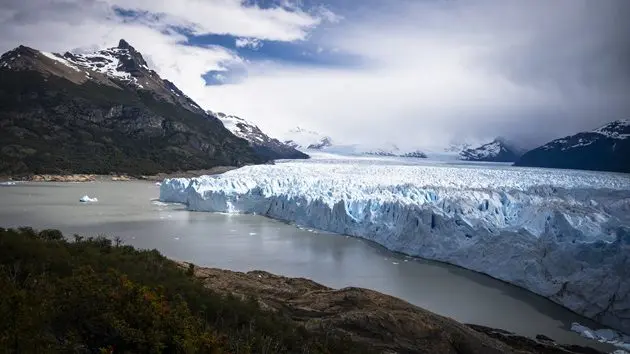(LONDON) — What was once considered the most stable glacier in the Patagonia region is experiencing ice loss at rates far greater than previously thought, according to new research.
The Perito Moreno Glacier in Argentina has retreated far more rapidly than expected in the past several years, according to a paper published Thursday in Communications Earth & Environment.
The glacier, measuring about 18.6 miles long, has retreated nearly half a mile in some areas over the past few years and could retreat by more than a mile in the near future, the study found. It is fed by the Southern Patagonian Ice Field in the Andes Mountains and terminates in Lago Argentino.
Previously painted as a glacier that “prevails in a changing climate,” researchers began closely studying Perito Moreno to compare it to other, less-stable glaciers, Moritz Koch, a researcher at the Friedrich Alexander University in Erlangen, Germany, and lead author of the study, told ABC News.
The scientists were left “baffled” over the unprecedented surface lowering rates seen at Perito Moreno, Koch said.
Perito Moreno remained relatively stable between 2000 and 2019, unlike most of the glaciers fed by the Patagonian Ice Fields. During that time frame, the glacier retreated about 328 feet, the researchers said.
But there has been a “substantial” increase in the rate of retreat since 2019, according to the paper.
“We do see that the stability of the glacier has come to an end, and it has, well, surpassed a tipping point,” Koch said. “That’s why we see this retreat happening.”
During two helicopter flights in 2022, researchers used radar to survey the thickness of the ice. They then combined that data with a survey of the lakebed beyond the glacier to investigate differences in the surface height and surface velocity of the glacier between 2000 and 2024.
In recent years, there has been more than a 16-fold increase in the thinning rate of the glacier at the terminus — where the glacier is currently grounded on in the water — from about 1 foot between 2000 and 2019 to an average of 18 feet between 2019 and 2024, the researchers found.
“This specific feature has stabilized the glacier over past decades, basically acting as a pinning point,” Koch said.
A large ridge beneath the terminus may have been responsible for the glacier’s stability before 2019.
Perito Moreno was like “climatically” out of balance on the surface, but kept physically in its position due to the bedrock ridge, Koch said.
But if the glacier continues to thin at the current rate, it will detach from the ridge and rapidly retreat, according to the paper. The increased water depth below the glacier would lead to an increased rate of calving.
As the frontal position changes in the glacial troughs to the north and east of Perito Moreno, the additional water surrounding the glacier is able to destabilize it and make it buoyant — causing a feedback loop of melting, Koch said.
“So, eventually, the water is able to lift up the glacier from its bed, and this facilitates this very strong calving activity that we are seeing right now,” he said.
As one of the most famous glaciers in the world, the Perito Moreno Glacier is a major tourist destination in Argentina and was declared a UNESCO World Heritage Site in 1981.
“It’s a very important economic factor for the region,” Koch said.
Climate change is likely playing a significant role in the ice loss of glaciers in the Patagonia region, Koch said.
“We do see a gradual increase in temperatures in the past decade, so warming definitely plays a substantial role in why glaciers are melting on the surface,’ he said.
Glaciers all over the world are at risk of significant ice loss due to global warming, according to scientists.
Between 2000 and 2023, glaciers lost an estimated 7,211 billion tons of ice, equating to an average annual loss of 301 billion tons, according to study published in Nature in February.
In the past two decades, the rate of ice loss has increased by about 36% in the past two decades, the researchers found.
Even if temperatures were to stabilize at current levels, glaciers around the world will likely lose at least 39% of mass, according to the World Economic Forum.
Melting glaciers and ice sheets are significant contributors to sea level rise. If all of the glaciers on Earth were to melt, it would contribute to an additional 230 feet of ocean water, according to the U.S. Geological Survey.
Copyright © 2025, ABC Audio. All rights reserved.






